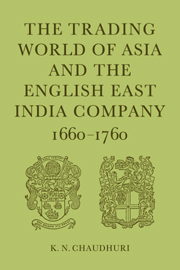Book contents
- Frontmatter
- Contents
- Tables
- Figures
- Maps
- Abbreviations
- Notes on dates, contemporaneous spellings, currency, and weights
- Preface
- Acknowledgements
- 1 The international economy and the East India trade
- 2 A formal theoretical model of the East India Company's trade
- 3 The structure of early trade and the pattern of commercial settlements in Asia
- 4 The evolution of the Company's trading system: operation and policy 1660–1760
- 5 Long-term trends and fluctuations 1660–1760
- 6 Politics of trade
- 7 Markets, merchants, and the Company
- 8 The export of treasure and the monetary system
- 9 The structure of country trade in Asia
- 10 Export of European commodities
- 11 The Company and the Indian textile industry
- 12 The Company's trade in textiles
- 13 Pepper
- 14 Import of bulk goods
- 15 Raw silk
- 16 Coffee
- 17 Imports from China
- 18 Financial results
- 19 Conclusion
- APPENDICES
- General glossary
- Bibliography
- Short titles cited in the reference notes
- Notes
- Index
9 - The structure of country trade in Asia
Published online by Cambridge University Press: 06 July 2010
- Frontmatter
- Contents
- Tables
- Figures
- Maps
- Abbreviations
- Notes on dates, contemporaneous spellings, currency, and weights
- Preface
- Acknowledgements
- 1 The international economy and the East India trade
- 2 A formal theoretical model of the East India Company's trade
- 3 The structure of early trade and the pattern of commercial settlements in Asia
- 4 The evolution of the Company's trading system: operation and policy 1660–1760
- 5 Long-term trends and fluctuations 1660–1760
- 6 Politics of trade
- 7 Markets, merchants, and the Company
- 8 The export of treasure and the monetary system
- 9 The structure of country trade in Asia
- 10 Export of European commodities
- 11 The Company and the Indian textile industry
- 12 The Company's trade in textiles
- 13 Pepper
- 14 Import of bulk goods
- 15 Raw silk
- 16 Coffee
- 17 Imports from China
- 18 Financial results
- 19 Conclusion
- APPENDICES
- General glossary
- Bibliography
- Short titles cited in the reference notes
- Notes
- Index
Summary
The general features of Asian trade: geographical areas and commercial characteristics
The European discovery of the commercial world of Asia in the sixteenth and seventeenth centuries not only revealed the potentials of the direct trade with Europe but also brought to light the existence of a widespread seaborne traffic in merchandise and men between its various ports and geographical regions. No account of the early European traveller in Asia was complete without a description of the commodities, merchants, and trade routes of the most important commercial centres to be found around the Indian Ocean. One of the earliest examples of such writings is the Suma Oriental by Tom'e Pires, the Portuguese apothecary, who went out to India in 1511 and later visited Malacca and China. In the preface to his book, which was dedicated to the king of Portugal, Pires announced that in the Suma he would speak not only of the Asian kingdom and regions but also of the dealings and trade they have with one another, without which they could not exist. For it was trade in general which ennobled kingdoms and cities and made their people great and also brought war and peace. So great was the desire for perfection among these early writers that many of them were led into eloquent description of places they had never visited and seen, because to leave them out would have been to make their accounts of Asia incomplete. Pires himself probably never travelled to the west of the coast of Malabar.
- Type
- Chapter
- Information
- The Trading World of Asia and the English East India Company1660-1760, pp. 191 - 214Publisher: Cambridge University PressPrint publication year: 1978
- 1
- Cited by



